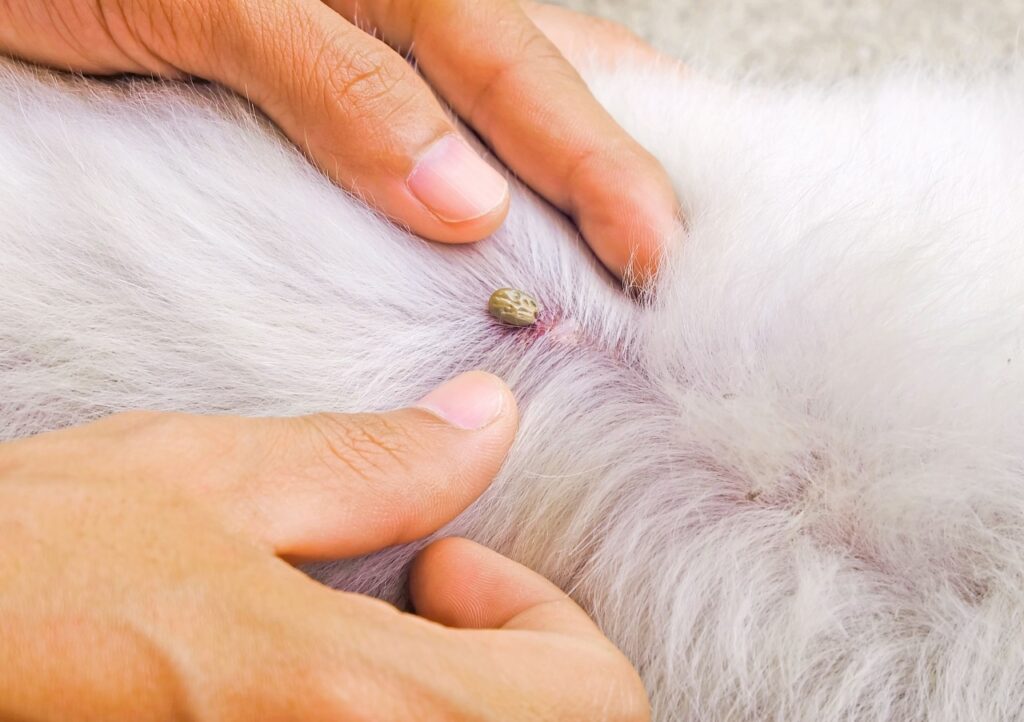Ticks are more than just a nuisance. An infestation can leave you vulnerable to diseases, such as lyme disease. They can also threaten the health and well-being of your pets.
Our team of experts is able to properly inspect your home or business for ticks, and take the action necessary to eliminate these pests once and for all. We aim to target the root of the problem, by breaking the breeding cycle in order to prevent future infestations from happening.
What do Ticks Look Like?
Ticks are parasitic, as they feed on the blood of animals. There are many tick species, and most are grayish-white, brown, black, yellow, or reddish-brown. Similar to spiders, adult ticks have eight legs. They are small, flat, and ovular, but once they’ve eaten, they become engorged. Ticks tend to prefer wooded and bushy areas. However, they can be tracked inside by pets and on your shoes and clothing.
Signs of a tick infestation include:
- Seeing a tick – where there’s one, there are more
- Small, irritating bites on your legs or other parts of your body
- Tick-borne illness – if you or a family member have symptoms such as headaches, fatigue, fever, rashes, or chills, it may be caused by ticks.
- Your pets are scratching or feeling restless
- Dark specks on your pet’s fur or skin
Types of Tick
There are several different types of ticks in MA. If you think that you have a tick infestation or are suffering from symptoms such as fever, rashes, nausea, and vomiting that you think may be caused by ticks, it is important to contact your health care provider as well as a professional pest control company that can properly inspect your home for ticks.
Below we list the most common types of ticks found in Massachusetts:
- Deer Ticks (also known as black-legged ticks): This type of tick is the most common in the Northeast, and it the most dangerous because it is known to carry Lyme disease. Deer ticks are usually found in tall grasses and bushes. They can also be found near fences.
- American Dog Ticks (also known as wood ticks): American dog ticks can also be dangerous, and are known to cause Rocky Mountain Spotted Fever (RMSF). If you or a family member is struggling with nausea, vomiting, or rashes that look like spots around wrists or ankles, it is important to consult a doctor and ensure that
- Brown Dog Ticks: These types of ticks can pose serious threats to your four-legged family members. As their name suggests, these types of ticks typically stick to dogs.
- Lone Star Ticks: Although these types of ticks are usually found in the South, in the last couple of years, we have seen an increase in them in the eastern part of the US, and especially New Jersey. These types of ticks are known to bite and can transmit a number of illnesses.
Ticks & Lyme Disease
One of the most significant concerns about ticks is that they are known to carry diseases, and in particular, Lyme disease. When an infected tick bites a host, it can spread the bacteria, Borrelia burgdorferi, which causes Lyme disease. The two types of ticks that most commonly spread Lyme disease in the U.S. are the black-legged tick and the western black-legged tick. Ticks are most active during the spring and summer months, and this is when you’re most likely to be bitten.
To help prevent a tick infestation, you should:
- When hiking or camping, avoid going off-trail or into heavily wooded areas where ticks like to live
- Wear long-sleeved shirts and tuck your pants into your socks when working outdoors during tick season
- Wear lighter colored clothes so that ticks are more easily spotted
- Inspect your pets before bringing them inside
- Use insect repellents to discourage ticks from hitching a ride
If you see ticks in your yard, on your pet, or yourself, you should schedule a pest inspection right away to ensure that the problem is handled quickly and effectively.

